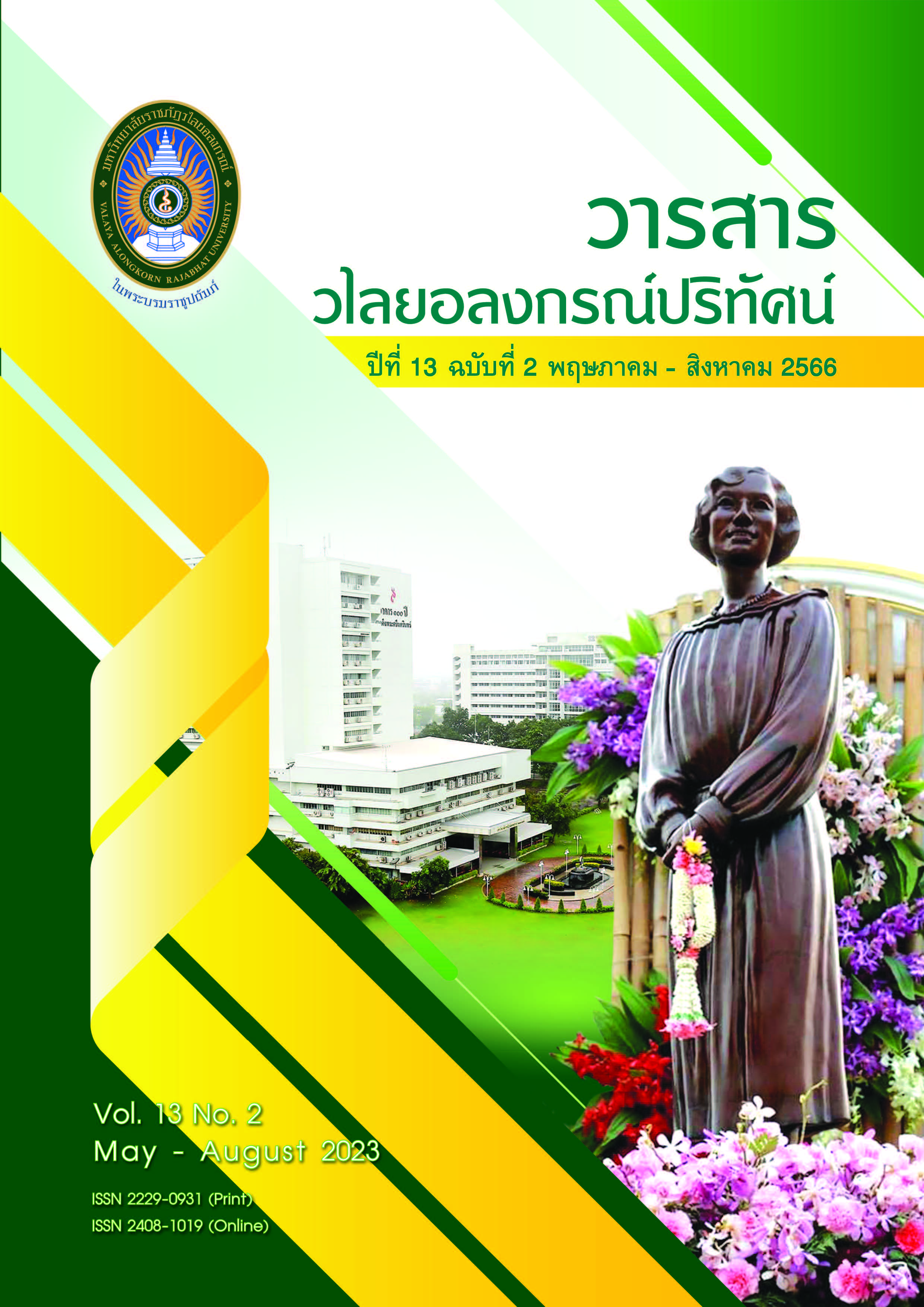ผลของรูปแบบการสอนแบบมีปฏิสัมพันธ์สี่มิติและสามระดับที่เน้นผู้เรียนเป็นสำคัญ (SCFTII) ต่อผลสัมฤทธิ์ทางการเรียนและความสามารถในการแก้ปัญหาร่วมกันของนักเรียน (CPS)
คำสำคัญ:
ผู้เรียนเป็นศูนย์กลาง , ผลสัมฤทธิ์ทางการเรียน, ความสามารถในการแก้ปัญหาร่วมกันบทคัดย่อ
การวิจัยนี้มีวัตถุประสงค์สองประการดังนี้ 1) เพื่อเปรียบเทียบผลสัมฤทธิ์ทางการเรียนก่อน และหลังเรียนที่เรียนด้วยรูปแบบการสอนแบบมีปฏิสัมพันธ์สี่มิติและสามระดับที่เน้นผู้เรียนเป็นสำคัญ (SCFTII) (Students-centered Four-dimensional and Three-degree Interactive Instructional: SCFTII) และ 2) เพื่อเปรียบเทียบความสามารถในการแก้ปัญหาร่วมกันของนักศึกษา (CPS) (collaborative problem-solving: CPS) โดยศึกษาประชากรกลุ่มนักศึกษา 1,080 คน และกลุ่มตัวอย่างประกอบด้วย นักศึกษา 30 คน ในระดับมัธยมศึกษาตอนปลายจากโรงเรียนลำดับ 1 ของมณฑลซ่างสุ่ย (ShangShui) ประเทศจีน ซึ่งได้รับคัดเลือกโดยวิธีการสุ่มแบบกลุ่ม เครื่องมือที่ใช้ในการวิจัยประกอบด้วย แบบทดสอบวัดผลสัมฤทธิ์ทางการเรียน และแบบทดสอบความสามารถในการแก้ปัญหาแบบร่วมมือ (CPS) โดยมีแบบวัดคุณภาพผลสัมฤทธิ์ทางการเรียน ดังนี้: มีค่าความยาก-ง่าย ที่ 0.52 ซึ่งอยู่ในช่วงค่าความยาก-ง่ายเฉลี่ย 0.20-0.80, ค่าอำนาจจำแนก ที่ 0.43 ซึ่งอยู่ในช่วงอำนาจจำแนกที่ดี 0.40-0.70, ค่าดัชนีความเที่ยงตรงของแบบสอบถาม (Item Objective Consistency: IOC) ของแบบทดสอบวัดผลสัมฤทธิ์ทางการเรียนแบบเลือกตอบ 50 ข้อ มีค่าเท่ากับ 0.80-1.0 ซึ่งสูงกว่าเกณฑ์ ที่ 0.5 สำหรับคุณภาพของแบบทดสอบความสามารถในการแก้ปัญหาแบบร่วมมือ (CPS) ดังนี้: ความยาก-ง่ายอยู่ที่ 0.50 ซึ่งอยู่ในช่วงความยาก-ง่ายเฉลี่ย 0.20-0.80, ค่าอำนาจจำแนกอยู่ระหว่างคือ 0.45 เพิ่มขึ้นจาก 0.30, ค่าดัชนีค่าความเที่ยงตรงของแบบสอบถามของแบบทดสอบวัดผลสัมฤทธิ์ทางการเรียนในของรูปแบบของคำถามเชิงสถานการณ์ 4 ข้อในแบบทดสอบการแก้ปัญหาแบบร่วมมือพบว่ามีค่าเท่ากับ 0.80-1.0 ซึ่งสูงกว่าเกณฑ์ ที่ 0.5 โดยสถิติที่ใช้ในการวิเคราะห์ข้อมูล ได้แก่ การทดสอบค่า t-test สำหรับตัวอย่างอิสระ และการทดสอบค่าt-test สำหรับตัวอย่าง 1 กลุ่ม ผลการวิจัยพบว่า 1)นักเรียนมีผลสัมฤทธิ์ทางการเรียนหลังเรียนด้วยรูปแบบที่พัฒนาขึ้นสูงกว่าก่อนเรียนอย่างมีนัยสำคัญทางสถิติ 2)ความสามารถในการแก้ปัญหาแบบร่วมมือของนักเรียนภายหลังการเรียนรู้ผ่านรูปแบบที่พัฒนาขึ้นสูงกว่าเกณฑ์ 70% อย่างมีนัยสำคัญ
เอกสารอ้างอิง
Aujchara Khujun. (2002). The Development of Students-Centered Instructional Activities for Bio-Physical Science for Mathayom Suksa IV Students in Sichompusuksa School. Master thesis. Khon Kaen University.
Cai Nanrong. (2004). Interactive generation teaching. Shanghai: Shanghai Sanlian Bookstore Press.
Chen Junlin. (2004). Cooperation learning, communication help and academic performance. Journal of Zhengzhou Academy of Aeronautics Industry Management: Social Science Edition. 23(1): 3.
Fu Hui. (2013). The positioning of teachers and students interacting roles in the cooperative teaching mode. China Education Journal. (S4): 2.
General Office of the State Council. (2019). The Guidance on Promoting the Reform of Regular Senior High School Education in the New Era. (China Office of Development [2019] No. 29). [Online], Available: http://www.gov.cn/zhengce/content/2019-06/19/content_5401568.htm?trs=1
Guo Dongmei. (2006). Practical interactive teaching, give play to the role of students, water conservancy education. 115-116.
Jin Liangyou. (2008). A method that effectively improves students' academic performance-cooperative learning. Science and technology information: academic research. (21): 283.
Jirakan Hongchuta. (2002). The Development of Chile-centered Instructional Activities based on CIPPA Model for Teaching Fraction to Prathomsuksa III Students. Master thesis. Khon Kaen University.
Kamonwan Phothibundit. (2000). A Development of Teaching/Learning Activities for Science Subject for Mathayom Suksa I based on Cooperative Learning Model. Master thesis. Khon Kaen University.
Kang Denghui. (2021). Promote the improvement of student problems in interactive exchanges. Education industry. (22): 3.
Li Chunjing. (2004). Discussion on the student-centric teaching mode based on communication theory. Journal of Shenyang Education Institute. 6(2): 4.
Lin Chongde, & Hu Weiping. (2010). Basic theory of thinking classroom teaching. Copy newspaper materials: Education and Digest. (3): 2.
Lin Wenliang. (2006). The problems and countermeasures of cooperative learning. Cantonese Education: Teaching and Research Edition. (6): 2.
Natkanya Jarearnkietboworn. (2004). A Study of Mathematical Problem-Solving Abilities in “Function” of The Second-Year Vocational Students through Cooperative Learning. Master Thesis. Srinakharinwirot University.
Nittaya Yonwichai. (2002). The Development of Child-Centered Instruction Activities Based on Cooperative Learning for Teaching Decimals to Prathomsuksa V Students. Master thesis. Khon Kaen University.
Sukanya Thongwat. (2002). The Development of Teaching and Learning Science Activities with the Use of the Inquiry Training Model and the Cooperative Learning Model for Mathayon Suksa 3 Students. Master thesis.Khon Kaen University.
The General Office of the CPC Central Committee and The General Office of the State Council. (2017). Opinions on Deepening the Reform of the Educational System and Mechanism. Retrieved from http://www.gov.cn/xinwen/2017-09/24/content_5227267.htm
The Ministry of Education. (2001). Outline of Basic Education Curriculum Reform (Trial) (KiU No.17 (2001). Retrieved from http://www.gov.cn/gongbao/content/2002/content_61386.htm
The Ministry of Education. (2010). Outline of the National Program for Medium - and Long-term Education Reform and Development (2010-2020). Retrieved from http://www.moe.gov.cn/srcsite/A01/s7048/201007/t20100729_171904.html
The Ministry of Education. (2017,2021 revised). The New Curriculum Standards. Retrieved from https://baijiahao.baidu.com/s?id=1636767377141838777
The UNESCO. (1998). Declaration of the 1998 UNESCO World Congress on Higher Education. Retrieved from https://www.doc88.com/p-1418081883701.html
Xie Liren, Yu Anshun, & Wang Guohua. (2007). Combining with the problem solving and cooperative learning strategy implementation in the action of action in middle schools. Science education. (13): 130-151.
Xiong Xiaoyan. (2003). Two thinking about promoting the teaching mode of teachers and students. Jiangsu Higher Education.
Xu Jianping. (2013). Teachers and students' two-way interaction high-efficiency moral education classroom. Teaching of ideological and political courses. (11): 3. 3.
Xu Jinzheng. (2021). The "participating" classroom teaching level with students as the main body-clustering analysis based on OECD global teaching insights video research data. Global education outlook.
Zhang Aili. (2022). The depth, breadth, and accuracy of class dialogue. Education theory and practice. 42(23): 4.
Zhang Hui. (2020). The influence of teaching methods and teaching situations on teachers and students. Doctoraral dissertation. Hebei Normal University.
Zhang Jie. (2013). Highlight the status of students' subjects and try to interact with teachers and students. Education and Teaching Forum. (35): 179-180.
Zhang Sulan, & Li Jinglong. (2012). Academic Education: Breaking through the 5 major bottlenecks of cooperative learning. Tianjin: Tianjin Education Press.
Zhu Hongmei. (2006). Interactive teaching: Student-centric teaching mode. Vocational University News.
ดาวน์โหลด
เผยแพร่แล้ว
รูปแบบการอ้างอิง
ฉบับ
ประเภทบทความ
สัญญาอนุญาต
ลิขสิทธิ์ (c) 2023 ไอลี่ จาง, เลอลักษณ์ โอทกานนท์, เรขา อรัญวงศ์, วัสส์พร จิโรจพันธุ์

อนุญาตภายใต้เงื่อนไข Creative Commons Attribution-NonCommercial-NoDerivatives 4.0 International License.
ข้อความที่ปรากฏในบทความแต่ละเรื่องในวารสารวไลยอลงกรณ์ปริทัศน์ เป็นความคิดเห็นของผู้นิพนธ์แต่ละท่าน มิใช่เป็นทัศนะและมิใช่ความรับผิดชอบของกองบรรณาธิการจัดทำวารสาร และ
มหาวิทยาลัยราชภัฏวไลยอลงกรณ์ ในพระบรมราชูปถัมภ์


